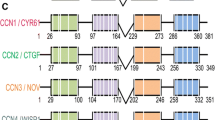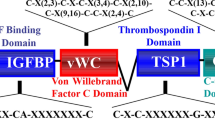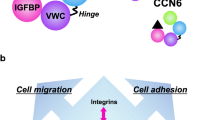Abstract
CCN2, also known as connective tissue growth factor, is a member of the CCN (CCN1–6) family of modular matricellular proteins. Analysis of CCN2 function in vivo has focused primarily on its key role as a mediator of excess ECM synthesis in multiple fibrotic diseases. However, CCN2 and related family members are widely expressed during development. Recent studies using new genetic models are revealing that CCN2 has essential roles in the development of many tissues. This review focuses on current and emerging data on CCN2 and its functions in chondrogenesis and angiogenesis, and on new studies showing that CCN2 has essential functions during embryonic and postnatal development in a number of epithelial tissues.


Similar content being viewed by others
References
Abreu JG, Reversade B, De Robertis EM (2002) Connective-tissue growth factor (CTGF) modulates cell signalling by BMP and TGF-beta. Nat Cell Biol 4:599–604
Brigstock DR (1999) The connective tissue growth factor/cysteine-rich 61/nephroblastoma overexpressed (CCN) family. Endocr Rev 20:189–206
Vorwerk P, Oh Y, Rosenfeld RG, Shymko RM (2002) Binding properties of insulin-like growth factor binding protein-3 (IGFBP-3), IGFBP-3 N- and C-terminal fragments, and structurally related proteins mac25 and connective tissue growth factor measured using a biosensor. Endocrinology 143:1677–1685
Chen N, Todorovic V, Lam SC, Lau LF (2004) Identification of a novel integrin alphavbeta3 binding site in CCN1 (CYR61) critical for pro-angiogenic activities in vascular endothelial cells. J Biol Chem 279:44166–44176
Leu SJ, Lau LF (2002) Proangiogenic activities of CYR61 (CCN1) mediated through integrins avb3 and a6b1 in human umbilical vein endothelial cells. J Biol Chem 286:25505–25518
Gao R (2004) Connective tissue growth factor (CCN2) induces adhesion of rat activated hepatic stellate cells by binding of its C-terminal domain to integrin alpha(v)beta(3) and heparan sulfate proteoglycan. J Biol Chem 279:8848–8855
Aoyama E, Hoshijima M, Araki D, Nishida T, Kubota S, Takigawa M (2009) N-terminal domains of CCN family 2/connective tissue growth factor bind to aggrecan. Biochem J 420:413–420
Hashimoto G, Fujii Y, Aoki T, Ikeda E, Okada Y (2002) Matrix metalloproteinases cleave connective tissue growth factor and reactivate angiogenic activity of vascular endothelial growth factor 165. J Biol Chem 277:36288–36295
Bork P (1993) The modular architecture of a new family of growth regulators related to connective tissue growth factor. FEBS 327:125–130
Itasaki N, Mercurio S, Rowe A, Domingos PM, Smith JC, Krumlauf R (2003) Wise, a context-dependent activator and inhibitor of Wnt signalling. Development 130:4295–4305
Katsube K, Tamamura Y, Yamaguchi (2009) Role of CCN, a vertebrate specific gene family, in development. Dev Growth Differ 51:55–67
Mercurio S, Itasaki N, Krumlauf R, Smith JC (2004) Connective-tissue growth factor modulates WNT signalling and interacts with the WNT receptor complex. Development 131:2137–2147
Nishida T, Kubota S, Fukunaga T, Kondo S, Yosimichi G et al (2003) CTGF/Hcs24, hypertrophic chondrocyte-specific gene product, interacts with perlecan in regulating the proliferation and differentiation of chondrocytes. J Cell Physiol 196:265–275
Perbal B, Sainson R, Werner M, He B, Roizman B (1999) The C-terminal domain of the regulatory protein NOVH is sufficient to promote interaction with fibulin 1C: a clue for a role of NOVH in cell-adhesion signaling. Proc Natl Acad Sci USA 96:869–874
Leask A (2006) All in the CCN family: essential matricellular signaling modulators emerge from the bunker. J Cell Sci 119:4803–4810
Mercurio S, Latinkic B, Itasaki N, Krumlauf R, Smith JC (2004) Connective-tissue growth factor modulates WNT signalling and interacts with the WNT receptor complex. Development 131:2137–2147
Fernando CA, Conrad PA, Bartels CF, Marques T, To M, Balow SA, Nakamura Y, Warman ML (2010) Temporal and spatial expression of CCN genes in zebrafish. Dev Dyn 239:1755–1767
Ivkovic S, Popoff SN, Safadi FF, Libuda DE, Stephenson RC, Daluiski A, Lyons KM (2003) Connective tissue growth factor coordinates chondrogenesis and angiogenesis during skeletal development. Development 130:2779–2791
Chiou MJ, Wu JL, Kuo CM, Chen JY (2006) The physiological role of CTGF/CCN2 in zebrafish notochond development and biological analysis of the proximal promoter region. Biochem Biophys Res Commun 349:750–758
Friedrichsen S, Christ S, Winckler M, Brauer D, Bauer K, Raivich G (2003) CTGF expression during mouse embryonic development. Cell Tiss Res 312:175–188
Brigstock DR (2002) Regulation of angiogenesis and endothelial cell function by connective tissue growth factor (CTGF) and cysteine-rich 61 (CYR61). Angiogenesis 5:153–165
Surveyor GA (1999) Immunohistochemical localization of connective tissue growth factor (CTGF) in the mouse embryo between days 7.5 and 14.5 of gestation. Growth Factors 17:115–124
Chen CC (2009) Functions and mechanisms of action of CCN matricellular proteins. Int J Biochem Cell Biol 41:771–783
Surveyor GA, Brigstock DR (1998) Localization of connective tissue growth factor during the period of embryo implantation in the mouse. Biol Reprod 59:1207–1213
Shi-Wen X, Abraham D (2008) Regulation and function of connective tissue growth factor/CCN2 in tissue repair, scarring and fibrosis. Cytokine Growth Factor Rev 19:133–144
Mori T, Shinozaki M, Hayashi N, Kakinuma T, Igarashi A, Takigawa M, Nakanishi T, Takehara K (1999) Role and interaction of connective tissue growth factor with transforming growth factor-beta in persistent fibrosis: a mouse fibrosis model. J Cell Physiol 181:153–159
Igarashi A, Bradham DM, Grotendorst GR (1993) Regulation of connective tissue growth factor gene expression in human skin fibroblasts and during wound repair. Mol Biol Cell 4:637–645
Yokoi H, Mori K, Kasahara M, Suganami T, Sawai K, Yoshioka T, Saito Y, Ogawa YKT, Sugawara A, Nakao K (2008) Overexpression of connective tissue growth factor in podocytes worsens diabetic nephropathy in mice. Kidney Int 73:446–455
Tong Z, Alt DS, Kemper S, Perbal B, Brigstock DR (2009) Susceptibility to liver fibrosis in mice expressing a connective tissue growth factor transgene in hepatocytes. Hepatology 50:939–947
Sonnylal S, Leoni P, Naff K, Van Pelt CS, Nakamura H, Leask A, Abraham D, Bou-Gharios G dCB (2010) Selective expression of connective tissue growth factor in fibroblasts in vivo promotes systemic tissue fibrosis. Arthritis Rheum 62:1523–1532
Liu S, Abraham DJ, Leask A (2011) CCN2 is required for bleomycin-induced skin fibrosis in mice. Arthritis Rheum 63:239–246
Doherty HE, Hiller S, Sulik KK, Maeda N (2010) A mouse strain where basal connective tissue growth factor gene expression can be switched from low to high. PLoS One 5:e12909
Teekakirikul P, Toka O, Alcalai R, Wang L, Wakimoto H, Nayor M, Konno T, Gorham JM, Wolf CM, Kim JB, Schmitt JP, Molkentin JD, Norris RA, Tager AM, Hoffman SR, Markwald RR, Seidman CE, Seidman JG (2010) Cardiac fibrosis in mice with hypertrophic cardiomyopathy is mediated by non-myocyte proliferation and requires Tgf-β. J Clin Invest 120:3520–3529
Panek AN, Alenina N, Ghadge SK, Erdmann B, Popova E, Perrot A, Geier C, Dietz R, Morano I, Bader M, Ozcelik C (2009) Connective tissue growth factor overexpression in cardiomyocytes promotes cardiac hypertrophy and protection against pressure overload. PLoS One 4:e6743
Ahmed MS, Martinov VN, von Lueder TG, Edvardsen T, Czibik G, Moe IT, Vinge LE, Oie E, Valen G, Attramadal H (2010) Mechanisms of novel cardioprotective functions of CCN2/CTGF in myocardial ischemia/reperfusion injury. Am J Physiol Heart Circ Physiol (Epub ahead of print)
Murphy AM (1996) Contractile protein phenotypic variation during development. Cardiovasc Res 31:25–33
Fukunaga T, Oya S, Takeshita N, Takigawa M, Takano-Yamamoto T (2003) Connective tissue growth factor mRNA expression pattern in cartilages is associated with their type I collagen expression. Bone 33:911–918
Friedrichsen S, Heuer H, Christ S, Cuthill D, Bauer K, Raivich G (2005) Gene expression of connective tissue growth factor in adult mouse. Growth Factors 23:43–53
Bonniaud P, Kolb M, Haberberger T, Kelly M, Robertson J, Gauldie J (2003) Adenoviral gene transfer of connective tissue growth factor in the lung induces transient fibrosis. Am J Respir Crit Care Med 168:770–778
Bonniaud P, Margetts PJ, Ask K, Robertson J, Gauldie J, Kolb M (2004) Connective tissue growth factor is crucial to inducing a profibrotic environment in “fibrosis-resistant” BALB/c mouse lungs. Am J Respir Cell Mol Biol 31:510–516
Wu S, Chen S, McNamara G, Whitsett J, Bancalari E (2009) Conditional overexpression of connective tissue growth factor disrupts postnatal lung development. Am J Respir Cell Mol Biol 42:552–563
Chen S, Platteau A, Hehre D, Smith H, Ruiz P, Whitsett JA, Bancalari E, Wu S (2011) CTGF Disrupts alveolarization and induces pulmonary hypertension in neonatal mice: implication in the pathogenesis of severe bronchopulmonary dysplasia. Am J Physiol Lung Cell Mol Physiol 300:L330–340
Delcommenne M, Gray V, Rue L, Woodgett J, Dedhar S (1998) Phosphoinositide-3-OH kinase-dependent regulation of glycogen synthase kinase 3 and protein kinase B/AKT by the integrin-linked kinase. Proc Natl Acad Sci USA 95:11211–11216
Henderson WR, Ye X, Nguyen C, Tien YT, Zhou B, Borok Z, Knight DA, Kahn M (2010) Inhibition of Wnt/beta-catenin/CREB binding protein (CBP) signaling reverses pulmonary fibrosis. Proc Natl Acad Sci USA 107:14309–14314
Chilosi M, Zamo A, Lestani M, Montagna L, Piccoli P, Pedron S, Bertaso M, Scarpa A, Murer B, Cancellieri A, Maestro R, Semenzato G, Doglioni C (2003) Aberrant Wnt/beta-catenin pathway activation in idiopathic pulmonary fibrosis. Am J Pathol 162:1495–1502
Cheon SS, Poon R, Alman BA (2004) Growth factors regulate beta-catenin-mediated TCF-dependent transcriptional activation in fibroblasts during the proliferative phase of wound healing. Exp Cell Res 293:267–274
Si W, Luu HH, Park JK, Luo Q, Song WX, Jiang W, Luo X, Li X, Yin H, Montag AG, Haydon RCHT (2006) CCN1/Cyr61 is regulated by the canonical Wnt signal and plays an important role in Wnt3A-induced osteoblast differentiation of mesenchymal stem cells. Mol Cell Biol 26:2955–2964
Huang BL, Lyons KM (2010) Stage-specific control of connective tissue growth factor (CTGF/CCN2) expression in chondrocytes by sox9 and beta-catenin. J Biol Chem 285:27702–27712
Baguma-Nibasheka M, Kablar B (2008) Pulmonary hypoplasia in the connective tissue growth factor (Ctgf) null mouse. Dev Dyn 237:485–493
Lindahl P, Johansson BR, Leveen P, Betsholtz C (1997) Pericyte loss and microaneurysm formation in PDGF-B-deficient mice. Science 277:242–245
Bonner JC (2004) Regulation of PDGF and its receptors in fibrotic diseases. Cytokine Growth Factor Rev 15:255–273
Provot S (2007) Fetal growth plate: a developmental model of cellular adaptation to hypoxia. Ann NY Acad Sci: 26–39
Kronenberg HM (2003) Developmental regulation of the growth plate. Nature 423:332–336
Nishida T, Baxter RM, Deyoung RA, Takigawa M, Lyons KM (2007) CCN2 (connective tissue growth factor) is essential for extracellular matrix production and integrin signaling in chondrocytes. J Cell Commun Signal 1:45–58
Gerber HP, Ryan AM, Kowalski J, Werb Z, Ferrara N (1999) VEGF couples hypertrophic cartilage remodeling, ossification and angiogenesis during endochondral bone formation. Nat Med 55:623–628
Nishida, T, Kondo S, Maeda A, Kubota S, Lyons KM, Takigawa M (2009) CCN family 2/connective tissue growth factor (CCN2/CTGF) regulates the expression of Vegf through Hif-1alpha expression in a chondrocytic cell line, HCS-2/8, under hypoxic condition. Bone 44:24–31
Gong S, Heintz N (2010) Rapid bacterial artificial chromosome modification for large-scale mouse transgenesis. Nat Protoc 5:1678–1696
Nishida T, Kojima S, Kuboki T, Nakao K, Kushibiki T, Tabata Y, Takigawa M (2004) Regeneration of defects in articular cartilage in rat knee joints by CCN2 (connective tissue growth factor). J Bone Miner Res 19:1308–1319
Blaney Davidson EN, Mooren FM, Oliver N, Berg WB, van der Kraan PM (2006) Connective tissue growth factor/CCN2 overexpression in mouse synovial lining results in transient fibrosis and cartilage damage. Arthritis Rheum 54:1653–1661
Schipani E (2005) Hypoxia and HIF-1 alpha in chondrogenesis. Semin Cell Dev Biol 16:539–546
Yang S, Ryu JH, Oh H, Chun CH, Kim BJ, Min BH, Chun JS (2010) Hypoxia-inducible factor 2alpha is a catabolic regulator of osteoarthritic cartilage destruction. Nat Med 16:687–693
Kawaki H, Kubota S, Suzuki A, Yamada T, Matsumura T et al (2008) Functional requirement of CCN2 for intramembranous bone formation in embryonic mice. Biochem Biophys Res Commun 366:450–456
Canalis E, Beamer WG, Economides AN, Smerdel-Ramoya A (2010) Connective tissue growth factor is required for skeletal development and postnatal skeletal homeostasis in male mice. Endocrinology 151:3490–3501
Lee CH, Moioli EK, Mao JJ (2010) CTGF directs fibroblast differentiation from human mesenchymal stem/stromal cells and defines connective tissue healing in a rodent injury model. J Clin Invest 120:3340–3349
Shimo T, Nishida T, Asano M, Kanyama M, Kuboki T, Tamatani T, Tezuka K, Takemura MMT, Takigawa M (1999) Connective tissue growth factor induces the proliferation, migration, and tube formation of vascular endothelial cells in vitro, and angiogenesis in vivo. J Biochem 126:137–145
Babic AM, Lau LF (1999) Fisp12/mouse connective tissue growth factor mediates endothelial cell adhesion and migration through integrin alphavbeta3, promotes endothelial cell survival, and induces angiogenesis in vivo. Mol Cell Biol 19:2958–2966
Inoki I, Hashimoto G, Enomoto H, Nakamura H, Makino KI, Ikeda E, Takata S, Kobayashi KOY (2001) Connective tissue growth factor binds vascular endothelial growth factor (VEGF) and inhibits VEGF-induced angiogenesis. FASEB J 16:219–221
Kuiper EJ, Ehlken C, Lambert V, van Treslong-de Groot HB, Lyons KM, Agostini HJRJ, Klaassen I, Van Noorden CJ, Goldschmeding R, Schlingemann RO (2007) Angiogenesis is not impaired in connective tissue growth factor (CTGF) knock-out mice. J Histochem Cytochem 55:1139–1147
Kuiper EJ, Roestenberg P, Lyons KM, Goldschmeding R, Klaassen I, Van Noorden CJSR (2008) Connective tissue growth factor is necessary for retinal capillary basal lamina thickening in diabetic mice. J Histochem Cytochem 56:785–792
Nguyen TQ, van Nieuwenhoven FA, Bovenschen N, Li Z, Xu L, Oliver N, Aten J, Joles JA, Vial C, Brandan E, Lyons KM, Goldschmeding R (2008) CTGF inhibits BMP-7 signaling in diabetic nephropathy. J Am Soc Nephrol 19:2098–2107
Crawford L, Guney MA, Oh YA, Deyoung RA, Valenzuela DM, Murphy AJ, Yancopoulos GD, Lyons KM, Brigstock DR, Economides A, Gannon M (2009) Connective tissue growth factor (CTGF) inactivation leads to defects in islet cell lineage allocation and beta-cell proliferation during embryogenesis. Mol Endocrinol 23:324–336
Kawaki H, Suzuki A, Lazar N, Yamada T, Matsumura T, Ohgawara T, Maeda T, Perbal BLK, Takigawa M (2008) Cooperative regulation of chondrocyte differentiation by CCN2 and CCN3 shown by a comprehensive analysis of the CCN family proteins in cartilage. J Bone Miner Res 23:1751–1764
Acknowledgements
This work was supported by NIH grants R01 AR052686 to KML and the UCLA Vascular Biology Training Grant (Ruth L. Kirschstein National Research Service Award T32HL69766) to FHG.
Author information
Authors and Affiliations
Corresponding author
Rights and permissions
About this article
Cite this article
Hall-Glenn, F., Lyons, K.M. Roles for CCN2 in normal physiological processes. Cell. Mol. Life Sci. 68, 3209–3217 (2011). https://doi.org/10.1007/s00018-011-0782-7
Received:
Revised:
Accepted:
Published:
Issue Date:
DOI: https://doi.org/10.1007/s00018-011-0782-7




